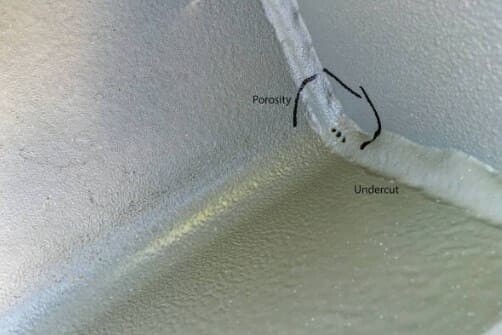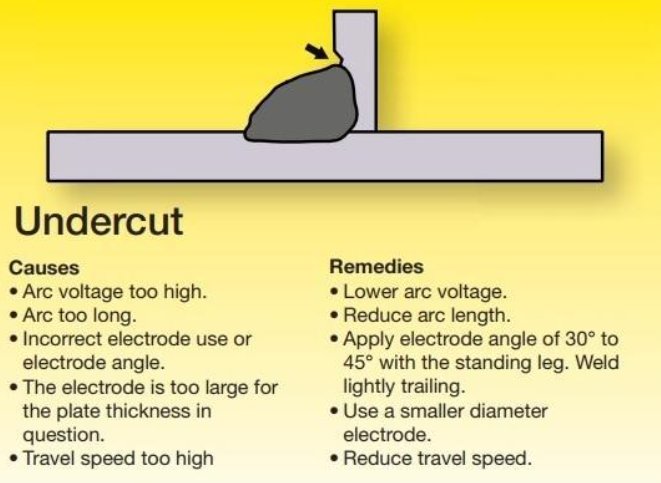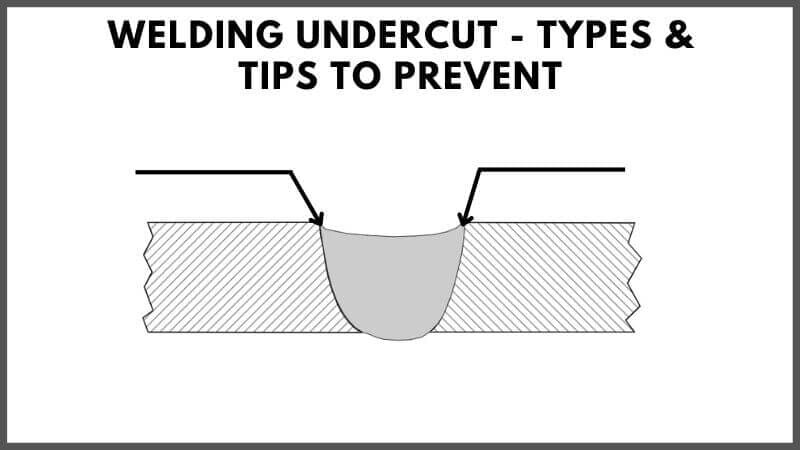I. What is an Undercut in Welding?
An undercut welding defect is one of the most common and undesirable defects that can occur in welding. It is a groove or depression that forms along the edge of the weld bead, where the base metal has melted but has not been filled by the filler metal. Welding undercut can reduce the cross-sectional area and strength of the weld joint and create stress concentration, fatigue cracking, and corrosion. Therefore, it is important to understand what causes an undercut welding defect, how to prevent it, and how to repair it.

II. Causes of Undercut on a Weld

Many factors cause an undercut on a weld, such as:
Excessive current or voltage: This can overheat the base metal and cause it to melt faster than the filler metal can fill the gap.
Improper electrode angle or size: This can affect the direction and distribution of the arc and create uneven heat input.
Incorrect filler metal or gas: This can create mismatched thermal expansion and contraction between the weld metal and the base metal, resulting in gaps and cracks.
Poor welding technique or speed: This can lead to insufficient penetration, deposition, or fusion of the filler metal.
Dampened or contaminated electrode: This can reduce the arc stability and quality, and introduce impurities into the weld pool.
Weld undercutting can occur in different types of welding processes, such as gas metal arc welding (GMAW), gas tungsten arc welding (GTAW), shielded metal arc welding (SMAW), flux-cored arc welding (FCAW), etc. It can also occur in different positions, such as flat, horizontal, vertical, or overhead. However, some positions are more prone to undercutting than others. For example, vertical and overhead positions tend to have a greater gravity effect on the molten metal, which can cause it to sag and leave a gap along the edge of the weld bead.
Weld undercutting can also be classified into two types: external welding undercut and internal welding undercut. External undercut is when the groove or depression is visible on the surface of the weld joint. An internal welding undercut is when the groove or depression is hidden inside the weld joint. External welding undercut is easier to detect and measure than internal welding undercut, but both types can affect the quality and performance of the weld joint.
II. Prevention of an Undercut in a Weld
To prevent undercut defects in welding, you need to adjust your welding parameters and technique according to the type of material, joint design, and position. Here are some tips and tricks to help you prevent undercut defects in welding:

Use appropriate current or voltage: You need to find the optimal setting that can create enough heat to melt the base metal and the filler metal, but not so much that it causes excessive melting or spatter. You can use a welding chart or calculator to determine the recommended current or voltage for your specific material and thickness.
Choose the right electrode angle or size: You need to hold the electrode at an angle that can create a uniform arc and heat distribution along the weld bead. Generally, you should use a 90-degree angle for flat or horizontal positions, a 45-degree angle for vertical positions, and a 5-15-degree angle for overhead positions. You also need to select an electrode size that matches the thickness of the base metal and the joint design. A smaller electrode can create a narrower arc and a smaller weld pool, which can reduce undercutting.
Select a suitable filler metal or gas: You need to use a filler metal that has similar properties and composition as the base metal, such as tensile strength, ductility, and thermal expansion. This can minimize the risk of cracking or distortion due to thermal stress. You also need to use a shielding gas that can protect the weld pool from atmospheric contamination and oxidation. For example, you can use argon or helium for non-ferrous metals, carbon dioxide or oxygen for carbon steel, and argon with carbon dioxide or oxygen for stainless steel.
Improve your welding technique or speed: You need to practice your welding skills and develop a consistent technique that can create smooth and even weld beads. You should avoid weaving or oscillating the electrode too much, as this can create uneven heat input and cause undercutting. You should also maintain a steady speed that matches the rate of filler metal deposition and base metal melting. A too-slow speed can cause excessive heat input and melting, while a too-fast speed can cause insufficient penetration and fusion.
Keep your electrodes dry or clean: You need to store your electrodes in a dry place or use a drying oven to prevent moisture absorption. Moisture can cause porosity, hydrogen embrittlement, and arc instability in your welds. You also need to clean your electrodes before use to remove any dirt, oil, grease, or rust that can contaminate your weld pool.
By following these tips and tricks, you can prevent undercut defects in welding and improve your welding quality and efficiency.
III. Repair of Undercut Defect in Welding
If you already have undercut defects in your welds, you need to repair them as soon as possible to restore their integrity and appearance. Here are some steps you can follow to fix undercut defects in welding:
Grind or gouge out the undercut area: You need to remove the defective metal along the edge of the weld bead using a grinding wheel or a gouging torch. You should create a smooth groove that is slightly wider than the original undercut.
Clean and prepare the groove: You need to clean the groove using a wire brush or a solvent to remove any slag, spatter, oxide, or impurities. You should also preheat the groove if necessary to reduce thermal stress and cracking.
Fill the groove with filler metal: You need to use a suitable filler metal and welding technique to fill the groove with multiple passes. You should start from one end of the groove and work your way to the other end, making sure each pass overlaps with the previous one. You should also control your heat input and speed to avoid creating new undercutting.
Finish and inspect the weld: You need to smooth out any rough edges or irregularities using a grinding wheel or a file. You should also clean any slag or spatter using a wire brush or a chipping hammer. Finally, you should inspect your weld using visual, mechanical, or non-destructive methods to ensure it is free of undercut and other defects.
An undercut welding defect is a serious defect that can affect the performance and durability of your welds. By following the tips and tricks above, you can prevent and correct undercut defects in welding and improve your welding quality and efficiency.
Related articles:
1. Welding Defects and Remedies in Steel Material
2. How to Identify the 7 Most Dangerous Welding Defects?
3. Tips for Troubleshooting Common MIG Weld Defects
4. Welding Defects, Problems And Easy Solutions [2023]
5. Inverter Welder Problems and How to Solve Them?






